WIB601: Social Media Impact on Commonwealth Bank of Australia
VerifiedAdded on 2022/11/01
|12
|3267
|400
Report
AI Summary
This report examines the impact of social media on the Commonwealth Bank of Australia (CBA). It identifies CBA's social media channels, including Facebook, Twitter, and LinkedIn, and how they are used for marketing, sales, and customer service. The analysis highlights the benefits of social media, such as enhanced customer service and transaction capabilities, alongside the negatives, including compliance concerns and reputation risks. The report identifies problems with CBA's current social media usage, like potential for identity fraud and lack of control over content. It recommends additional channels like Yelp and Pinterest for future business growth. The report concludes with recommendations for a forward-planning strategy to enhance CBA's social media presence and effectiveness.
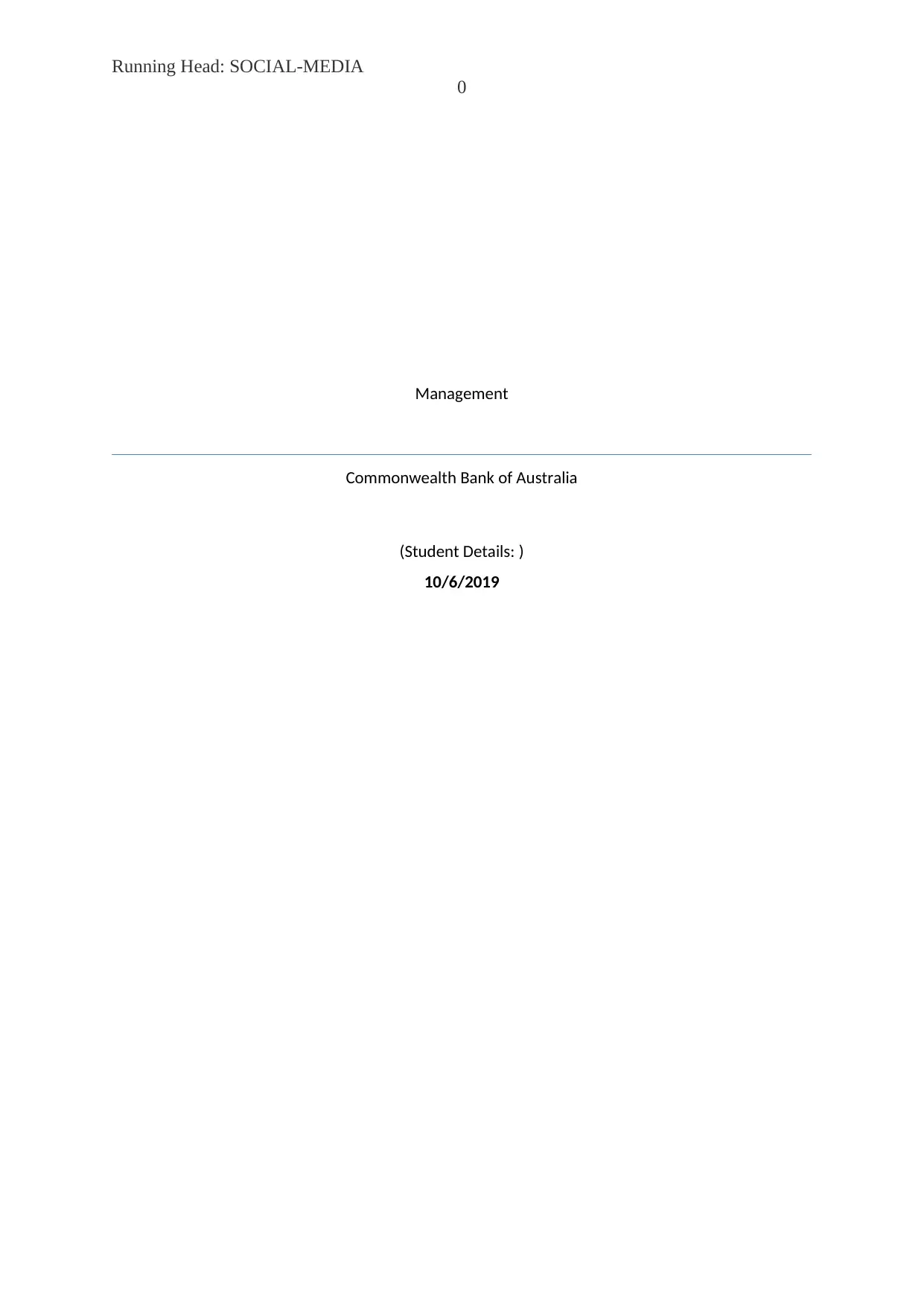
Running Head: SOCIAL-MEDIA
0
Management
Commonwealth Bank of Australia
(Student Details: )
10/6/2019
0
Management
Commonwealth Bank of Australia
(Student Details: )
10/6/2019
Paraphrase This Document
Need a fresh take? Get an instant paraphrase of this document with our AI Paraphraser
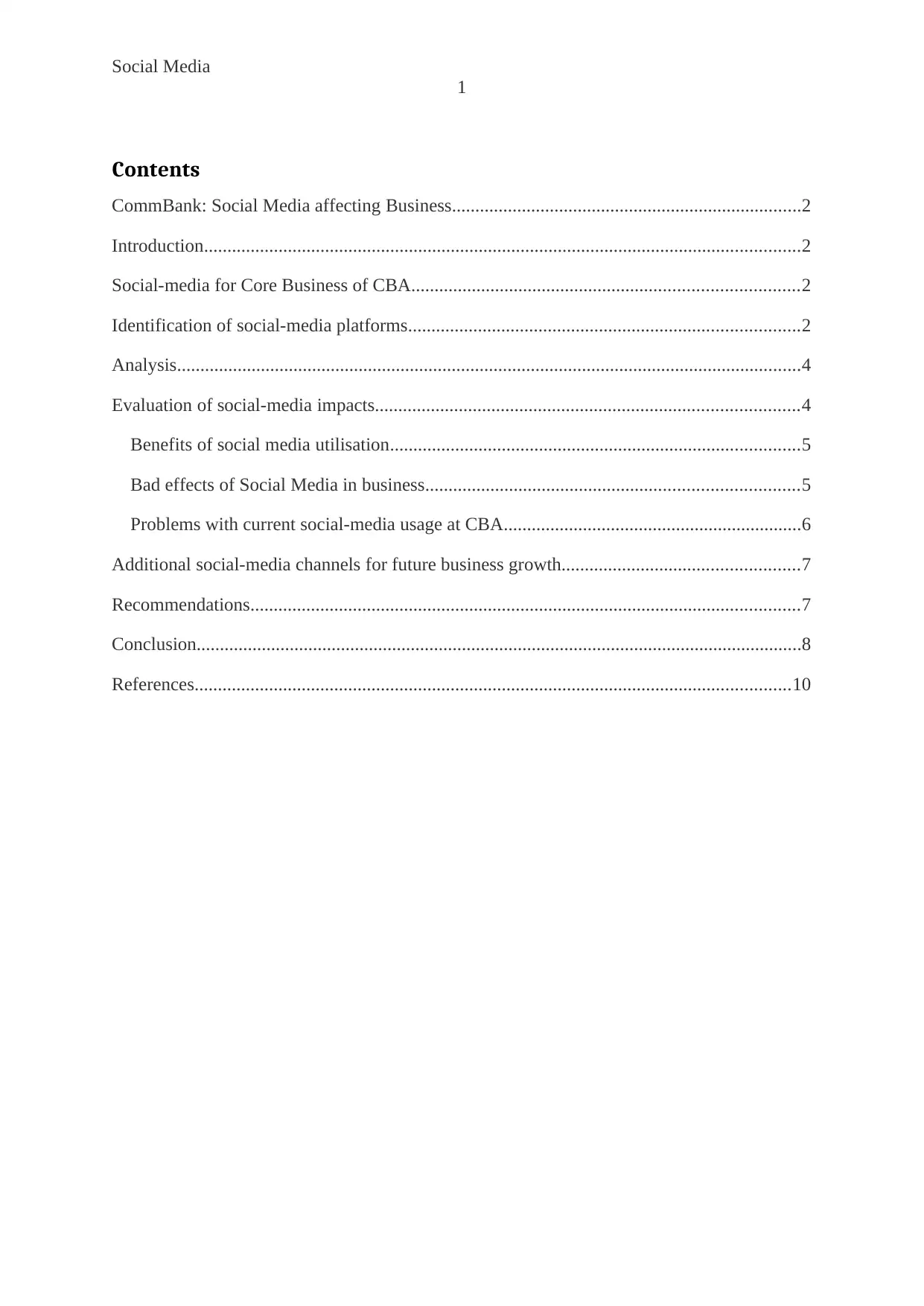
Social Media
1
Contents
CommBank: Social Media affecting Business...........................................................................2
Introduction................................................................................................................................2
Social-media for Core Business of CBA...................................................................................2
Identification of social-media platforms....................................................................................2
Analysis......................................................................................................................................4
Evaluation of social-media impacts...........................................................................................4
Benefits of social media utilisation........................................................................................5
Bad effects of Social Media in business................................................................................5
Problems with current social-media usage at CBA................................................................6
Additional social-media channels for future business growth...................................................7
Recommendations......................................................................................................................7
Conclusion..................................................................................................................................8
References................................................................................................................................10
1
Contents
CommBank: Social Media affecting Business...........................................................................2
Introduction................................................................................................................................2
Social-media for Core Business of CBA...................................................................................2
Identification of social-media platforms....................................................................................2
Analysis......................................................................................................................................4
Evaluation of social-media impacts...........................................................................................4
Benefits of social media utilisation........................................................................................5
Bad effects of Social Media in business................................................................................5
Problems with current social-media usage at CBA................................................................6
Additional social-media channels for future business growth...................................................7
Recommendations......................................................................................................................7
Conclusion..................................................................................................................................8
References................................................................................................................................10
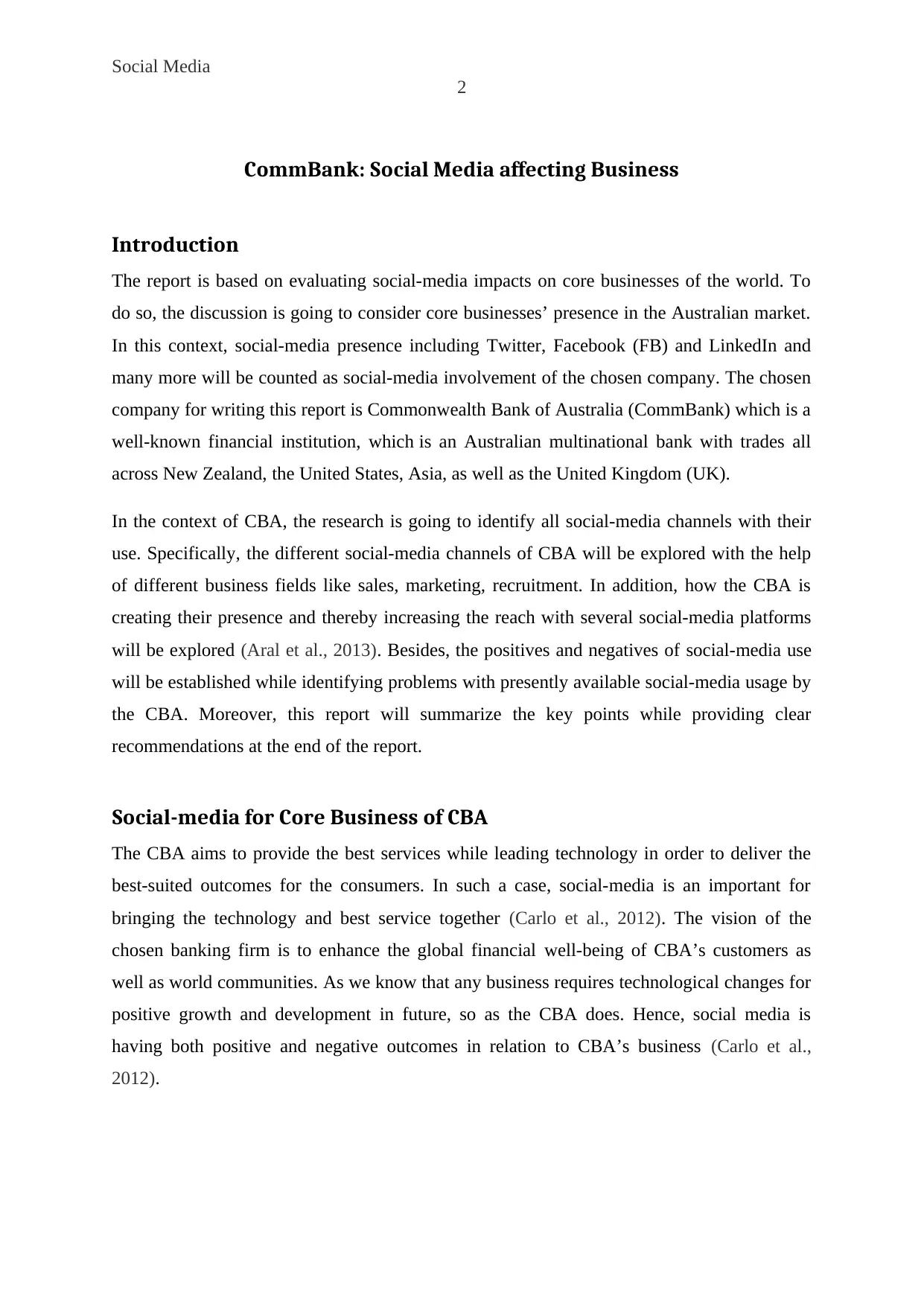
Social Media
2
CommBank: Social Media affecting Business
Introduction
The report is based on evaluating social-media impacts on core businesses of the world. To
do so, the discussion is going to consider core businesses’ presence in the Australian market.
In this context, social-media presence including Twitter, Facebook (FB) and LinkedIn and
many more will be counted as social-media involvement of the chosen company. The chosen
company for writing this report is Commonwealth Bank of Australia (CommBank) which is a
well-known financial institution, which is an Australian multinational bank with trades all
across New Zealand, the United States, Asia, as well as the United Kingdom (UK).
In the context of CBA, the research is going to identify all social-media channels with their
use. Specifically, the different social-media channels of CBA will be explored with the help
of different business fields like sales, marketing, recruitment. In addition, how the CBA is
creating their presence and thereby increasing the reach with several social-media platforms
will be explored (Aral et al., 2013). Besides, the positives and negatives of social-media use
will be established while identifying problems with presently available social-media usage by
the CBA. Moreover, this report will summarize the key points while providing clear
recommendations at the end of the report.
Social-media for Core Business of CBA
The CBA aims to provide the best services while leading technology in order to deliver the
best-suited outcomes for the consumers. In such a case, social-media is an important for
bringing the technology and best service together (Carlo et al., 2012). The vision of the
chosen banking firm is to enhance the global financial well-being of CBA’s customers as
well as world communities. As we know that any business requires technological changes for
positive growth and development in future, so as the CBA does. Hence, social media is
having both positive and negative outcomes in relation to CBA’s business (Carlo et al.,
2012).
2
CommBank: Social Media affecting Business
Introduction
The report is based on evaluating social-media impacts on core businesses of the world. To
do so, the discussion is going to consider core businesses’ presence in the Australian market.
In this context, social-media presence including Twitter, Facebook (FB) and LinkedIn and
many more will be counted as social-media involvement of the chosen company. The chosen
company for writing this report is Commonwealth Bank of Australia (CommBank) which is a
well-known financial institution, which is an Australian multinational bank with trades all
across New Zealand, the United States, Asia, as well as the United Kingdom (UK).
In the context of CBA, the research is going to identify all social-media channels with their
use. Specifically, the different social-media channels of CBA will be explored with the help
of different business fields like sales, marketing, recruitment. In addition, how the CBA is
creating their presence and thereby increasing the reach with several social-media platforms
will be explored (Aral et al., 2013). Besides, the positives and negatives of social-media use
will be established while identifying problems with presently available social-media usage by
the CBA. Moreover, this report will summarize the key points while providing clear
recommendations at the end of the report.
Social-media for Core Business of CBA
The CBA aims to provide the best services while leading technology in order to deliver the
best-suited outcomes for the consumers. In such a case, social-media is an important for
bringing the technology and best service together (Carlo et al., 2012). The vision of the
chosen banking firm is to enhance the global financial well-being of CBA’s customers as
well as world communities. As we know that any business requires technological changes for
positive growth and development in future, so as the CBA does. Hence, social media is
having both positive and negative outcomes in relation to CBA’s business (Carlo et al.,
2012).
⊘ This is a preview!⊘
Do you want full access?
Subscribe today to unlock all pages.

Trusted by 1+ million students worldwide
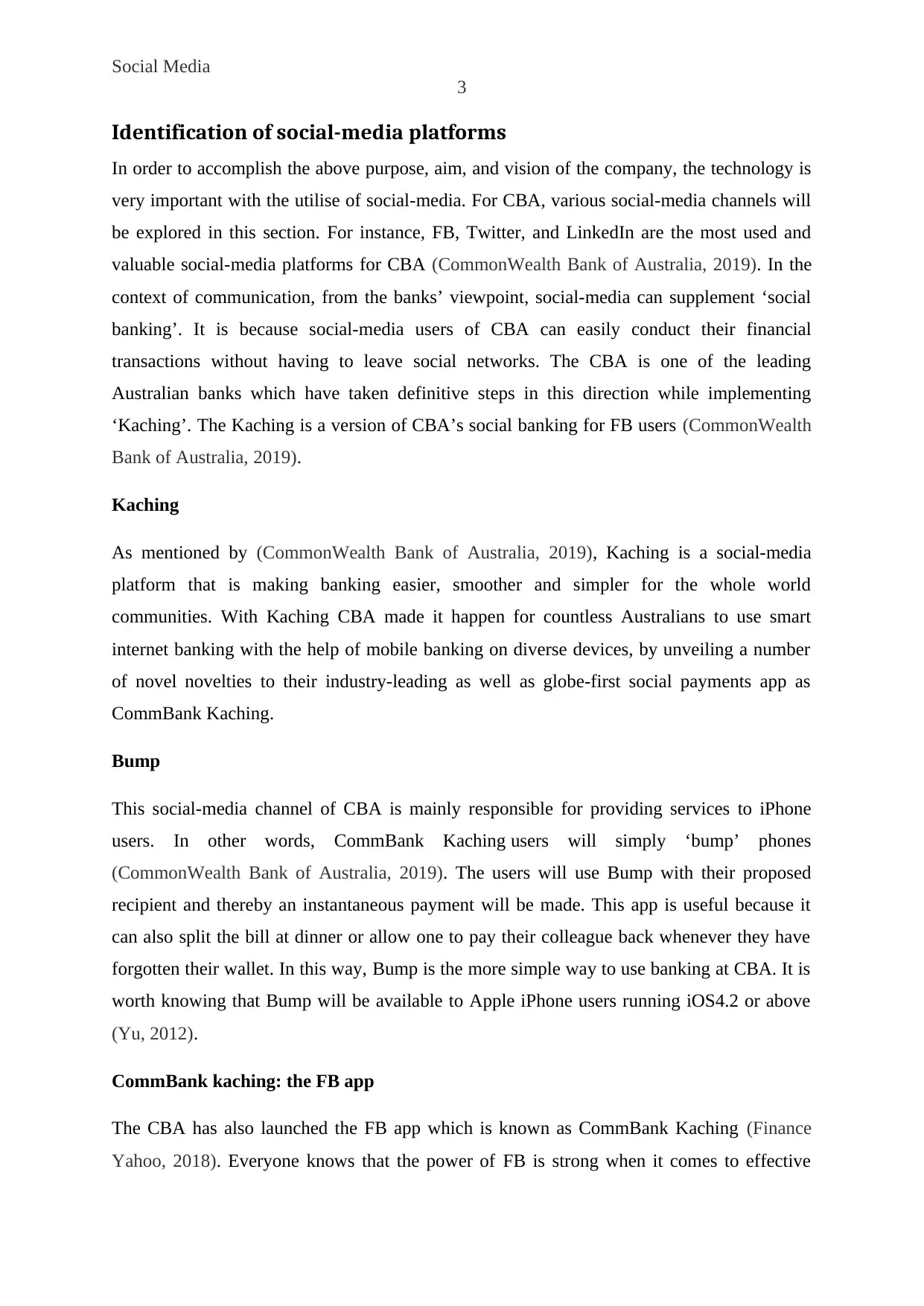
Social Media
3
Identification of social-media platforms
In order to accomplish the above purpose, aim, and vision of the company, the technology is
very important with the utilise of social-media. For CBA, various social-media channels will
be explored in this section. For instance, FB, Twitter, and LinkedIn are the most used and
valuable social-media platforms for CBA (CommonWealth Bank of Australia, 2019). In the
context of communication, from the banks’ viewpoint, social-media can supplement ‘social
banking’. It is because social-media users of CBA can easily conduct their financial
transactions without having to leave social networks. The CBA is one of the leading
Australian banks which have taken definitive steps in this direction while implementing
‘Kaching’. The Kaching is a version of CBA’s social banking for FB users (CommonWealth
Bank of Australia, 2019).
Kaching
As mentioned by (CommonWealth Bank of Australia, 2019), Kaching is a social-media
platform that is making banking easier, smoother and simpler for the whole world
communities. With Kaching CBA made it happen for countless Australians to use smart
internet banking with the help of mobile banking on diverse devices, by unveiling a number
of novel novelties to their industry-leading as well as globe-first social payments app as
CommBank Kaching.
Bump
This social-media channel of CBA is mainly responsible for providing services to iPhone
users. In other words, CommBank Kaching users will simply ‘bump’ phones
(CommonWealth Bank of Australia, 2019). The users will use Bump with their proposed
recipient and thereby an instantaneous payment will be made. This app is useful because it
can also split the bill at dinner or allow one to pay their colleague back whenever they have
forgotten their wallet. In this way, Bump is the more simple way to use banking at CBA. It is
worth knowing that Bump will be available to Apple iPhone users running iOS4.2 or above
(Yu, 2012).
CommBank kaching: the FB app
The CBA has also launched the FB app which is known as CommBank Kaching (Finance
Yahoo, 2018). Everyone knows that the power of FB is strong when it comes to effective
3
Identification of social-media platforms
In order to accomplish the above purpose, aim, and vision of the company, the technology is
very important with the utilise of social-media. For CBA, various social-media channels will
be explored in this section. For instance, FB, Twitter, and LinkedIn are the most used and
valuable social-media platforms for CBA (CommonWealth Bank of Australia, 2019). In the
context of communication, from the banks’ viewpoint, social-media can supplement ‘social
banking’. It is because social-media users of CBA can easily conduct their financial
transactions without having to leave social networks. The CBA is one of the leading
Australian banks which have taken definitive steps in this direction while implementing
‘Kaching’. The Kaching is a version of CBA’s social banking for FB users (CommonWealth
Bank of Australia, 2019).
Kaching
As mentioned by (CommonWealth Bank of Australia, 2019), Kaching is a social-media
platform that is making banking easier, smoother and simpler for the whole world
communities. With Kaching CBA made it happen for countless Australians to use smart
internet banking with the help of mobile banking on diverse devices, by unveiling a number
of novel novelties to their industry-leading as well as globe-first social payments app as
CommBank Kaching.
Bump
This social-media channel of CBA is mainly responsible for providing services to iPhone
users. In other words, CommBank Kaching users will simply ‘bump’ phones
(CommonWealth Bank of Australia, 2019). The users will use Bump with their proposed
recipient and thereby an instantaneous payment will be made. This app is useful because it
can also split the bill at dinner or allow one to pay their colleague back whenever they have
forgotten their wallet. In this way, Bump is the more simple way to use banking at CBA. It is
worth knowing that Bump will be available to Apple iPhone users running iOS4.2 or above
(Yu, 2012).
CommBank kaching: the FB app
The CBA has also launched the FB app which is known as CommBank Kaching (Finance
Yahoo, 2018). Everyone knows that the power of FB is strong when it comes to effective
Paraphrase This Document
Need a fresh take? Get an instant paraphrase of this document with our AI Paraphraser
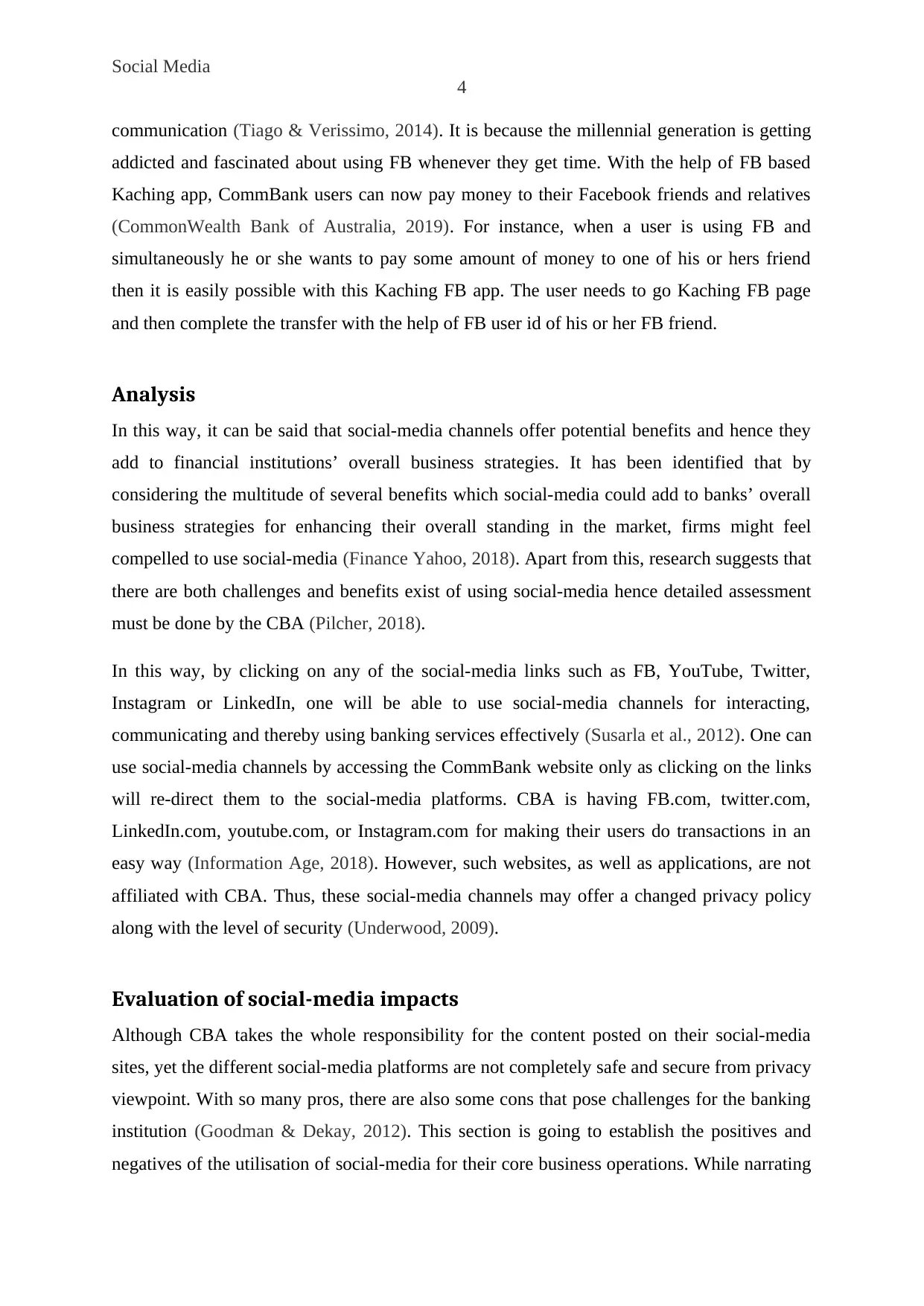
Social Media
4
communication (Tiago & Verissimo, 2014). It is because the millennial generation is getting
addicted and fascinated about using FB whenever they get time. With the help of FB based
Kaching app, CommBank users can now pay money to their Facebook friends and relatives
(CommonWealth Bank of Australia, 2019). For instance, when a user is using FB and
simultaneously he or she wants to pay some amount of money to one of his or hers friend
then it is easily possible with this Kaching FB app. The user needs to go Kaching FB page
and then complete the transfer with the help of FB user id of his or her FB friend.
Analysis
In this way, it can be said that social-media channels offer potential benefits and hence they
add to financial institutions’ overall business strategies. It has been identified that by
considering the multitude of several benefits which social-media could add to banks’ overall
business strategies for enhancing their overall standing in the market, firms might feel
compelled to use social-media (Finance Yahoo, 2018). Apart from this, research suggests that
there are both challenges and benefits exist of using social-media hence detailed assessment
must be done by the CBA (Pilcher, 2018).
In this way, by clicking on any of the social-media links such as FB, YouTube, Twitter,
Instagram or LinkedIn, one will be able to use social-media channels for interacting,
communicating and thereby using banking services effectively (Susarla et al., 2012). One can
use social-media channels by accessing the CommBank website only as clicking on the links
will re-direct them to the social-media platforms. CBA is having FB.com, twitter.com,
LinkedIn.com, youtube.com, or Instagram.com for making their users do transactions in an
easy way (Information Age, 2018). However, such websites, as well as applications, are not
affiliated with CBA. Thus, these social-media channels may offer a changed privacy policy
along with the level of security (Underwood, 2009).
Evaluation of social-media impacts
Although CBA takes the whole responsibility for the content posted on their social-media
sites, yet the different social-media platforms are not completely safe and secure from privacy
viewpoint. With so many pros, there are also some cons that pose challenges for the banking
institution (Goodman & Dekay, 2012). This section is going to establish the positives and
negatives of the utilisation of social-media for their core business operations. While narrating
4
communication (Tiago & Verissimo, 2014). It is because the millennial generation is getting
addicted and fascinated about using FB whenever they get time. With the help of FB based
Kaching app, CommBank users can now pay money to their Facebook friends and relatives
(CommonWealth Bank of Australia, 2019). For instance, when a user is using FB and
simultaneously he or she wants to pay some amount of money to one of his or hers friend
then it is easily possible with this Kaching FB app. The user needs to go Kaching FB page
and then complete the transfer with the help of FB user id of his or her FB friend.
Analysis
In this way, it can be said that social-media channels offer potential benefits and hence they
add to financial institutions’ overall business strategies. It has been identified that by
considering the multitude of several benefits which social-media could add to banks’ overall
business strategies for enhancing their overall standing in the market, firms might feel
compelled to use social-media (Finance Yahoo, 2018). Apart from this, research suggests that
there are both challenges and benefits exist of using social-media hence detailed assessment
must be done by the CBA (Pilcher, 2018).
In this way, by clicking on any of the social-media links such as FB, YouTube, Twitter,
Instagram or LinkedIn, one will be able to use social-media channels for interacting,
communicating and thereby using banking services effectively (Susarla et al., 2012). One can
use social-media channels by accessing the CommBank website only as clicking on the links
will re-direct them to the social-media platforms. CBA is having FB.com, twitter.com,
LinkedIn.com, youtube.com, or Instagram.com for making their users do transactions in an
easy way (Information Age, 2018). However, such websites, as well as applications, are not
affiliated with CBA. Thus, these social-media channels may offer a changed privacy policy
along with the level of security (Underwood, 2009).
Evaluation of social-media impacts
Although CBA takes the whole responsibility for the content posted on their social-media
sites, yet the different social-media platforms are not completely safe and secure from privacy
viewpoint. With so many pros, there are also some cons that pose challenges for the banking
institution (Goodman & Dekay, 2012). This section is going to establish the positives and
negatives of the utilisation of social-media for their core business operations. While narrating
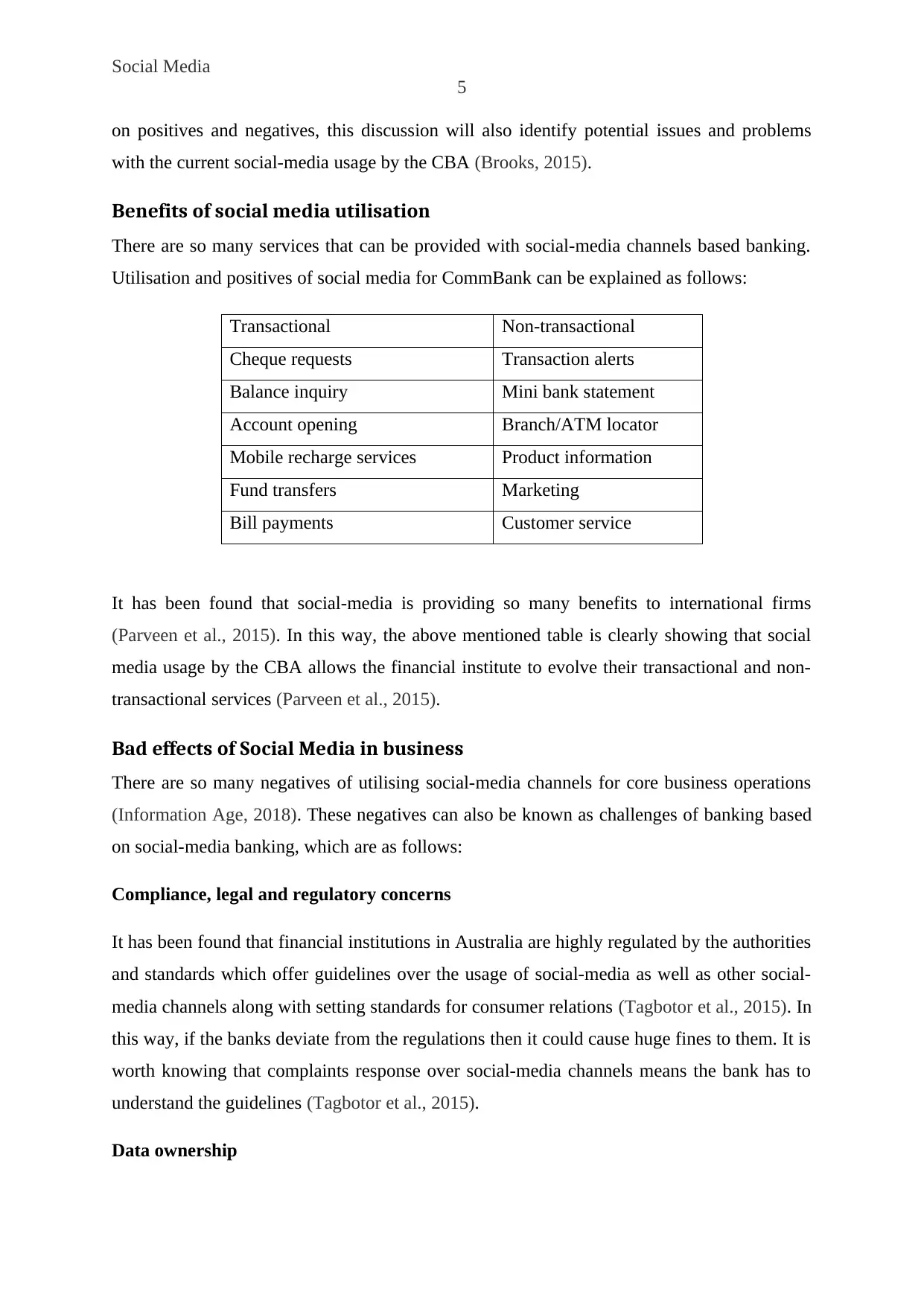
Social Media
5
on positives and negatives, this discussion will also identify potential issues and problems
with the current social-media usage by the CBA (Brooks, 2015).
Benefits of social media utilisation
There are so many services that can be provided with social-media channels based banking.
Utilisation and positives of social media for CommBank can be explained as follows:
Transactional Non-transactional
Cheque requests Transaction alerts
Balance inquiry Mini bank statement
Account opening Branch/ATM locator
Mobile recharge services Product information
Fund transfers Marketing
Bill payments Customer service
It has been found that social-media is providing so many benefits to international firms
(Parveen et al., 2015). In this way, the above mentioned table is clearly showing that social
media usage by the CBA allows the financial institute to evolve their transactional and non-
transactional services (Parveen et al., 2015).
Bad effects of Social Media in business
There are so many negatives of utilising social-media channels for core business operations
(Information Age, 2018). These negatives can also be known as challenges of banking based
on social-media banking, which are as follows:
Compliance, legal and regulatory concerns
It has been found that financial institutions in Australia are highly regulated by the authorities
and standards which offer guidelines over the usage of social-media as well as other social-
media channels along with setting standards for consumer relations (Tagbotor et al., 2015). In
this way, if the banks deviate from the regulations then it could cause huge fines to them. It is
worth knowing that complaints response over social-media channels means the bank has to
understand the guidelines (Tagbotor et al., 2015).
Data ownership
5
on positives and negatives, this discussion will also identify potential issues and problems
with the current social-media usage by the CBA (Brooks, 2015).
Benefits of social media utilisation
There are so many services that can be provided with social-media channels based banking.
Utilisation and positives of social media for CommBank can be explained as follows:
Transactional Non-transactional
Cheque requests Transaction alerts
Balance inquiry Mini bank statement
Account opening Branch/ATM locator
Mobile recharge services Product information
Fund transfers Marketing
Bill payments Customer service
It has been found that social-media is providing so many benefits to international firms
(Parveen et al., 2015). In this way, the above mentioned table is clearly showing that social
media usage by the CBA allows the financial institute to evolve their transactional and non-
transactional services (Parveen et al., 2015).
Bad effects of Social Media in business
There are so many negatives of utilising social-media channels for core business operations
(Information Age, 2018). These negatives can also be known as challenges of banking based
on social-media banking, which are as follows:
Compliance, legal and regulatory concerns
It has been found that financial institutions in Australia are highly regulated by the authorities
and standards which offer guidelines over the usage of social-media as well as other social-
media channels along with setting standards for consumer relations (Tagbotor et al., 2015). In
this way, if the banks deviate from the regulations then it could cause huge fines to them. It is
worth knowing that complaints response over social-media channels means the bank has to
understand the guidelines (Tagbotor et al., 2015).
Data ownership
⊘ This is a preview!⊘
Do you want full access?
Subscribe today to unlock all pages.

Trusted by 1+ million students worldwide
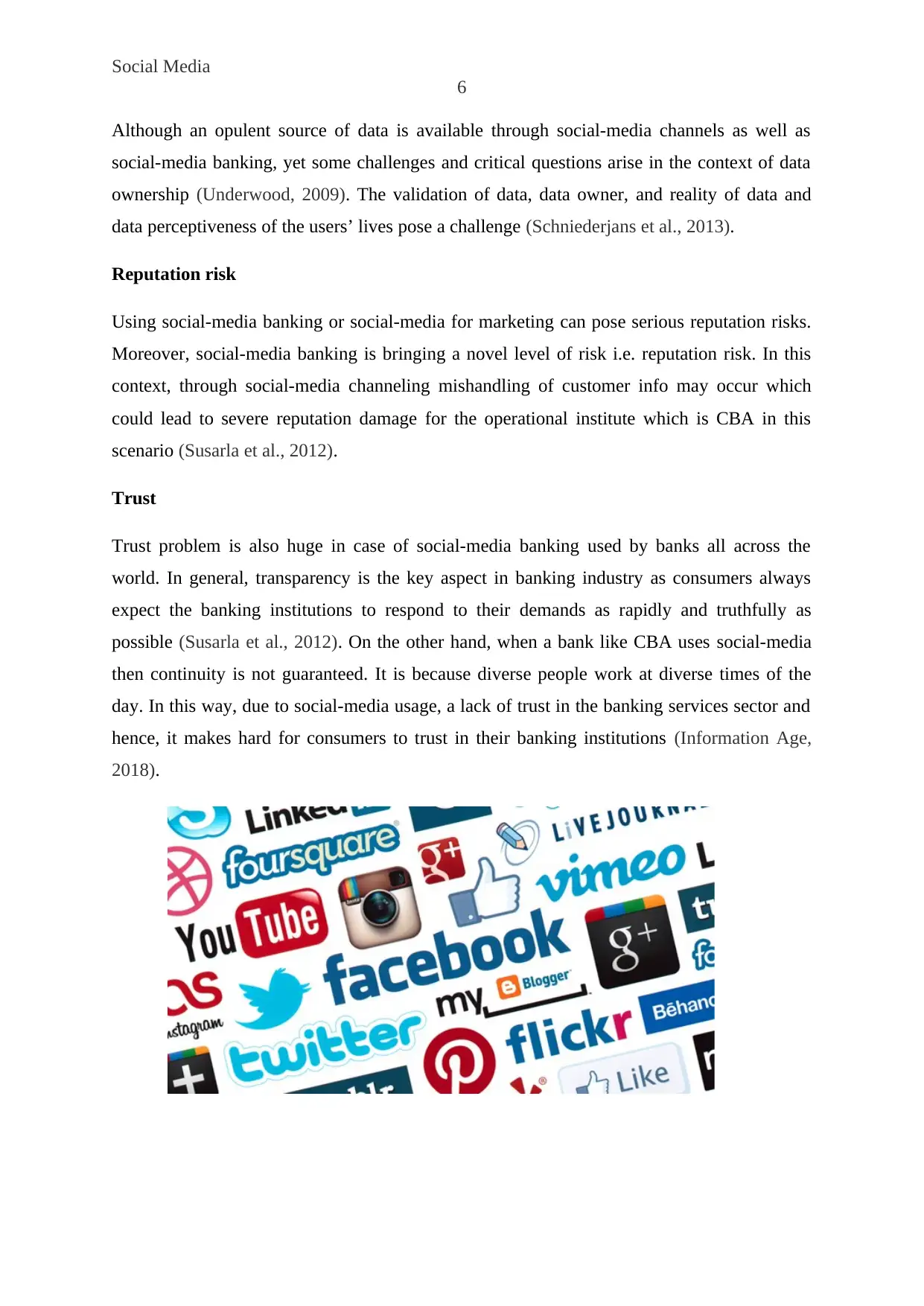
Social Media
6
Although an opulent source of data is available through social-media channels as well as
social-media banking, yet some challenges and critical questions arise in the context of data
ownership (Underwood, 2009). The validation of data, data owner, and reality of data and
data perceptiveness of the users’ lives pose a challenge (Schniederjans et al., 2013).
Reputation risk
Using social-media banking or social-media for marketing can pose serious reputation risks.
Moreover, social-media banking is bringing a novel level of risk i.e. reputation risk. In this
context, through social-media channeling mishandling of customer info may occur which
could lead to severe reputation damage for the operational institute which is CBA in this
scenario (Susarla et al., 2012).
Trust
Trust problem is also huge in case of social-media banking used by banks all across the
world. In general, transparency is the key aspect in banking industry as consumers always
expect the banking institutions to respond to their demands as rapidly and truthfully as
possible (Susarla et al., 2012). On the other hand, when a bank like CBA uses social-media
then continuity is not guaranteed. It is because diverse people work at diverse times of the
day. In this way, due to social-media usage, a lack of trust in the banking services sector and
hence, it makes hard for consumers to trust in their banking institutions (Information Age,
2018).
6
Although an opulent source of data is available through social-media channels as well as
social-media banking, yet some challenges and critical questions arise in the context of data
ownership (Underwood, 2009). The validation of data, data owner, and reality of data and
data perceptiveness of the users’ lives pose a challenge (Schniederjans et al., 2013).
Reputation risk
Using social-media banking or social-media for marketing can pose serious reputation risks.
Moreover, social-media banking is bringing a novel level of risk i.e. reputation risk. In this
context, through social-media channeling mishandling of customer info may occur which
could lead to severe reputation damage for the operational institute which is CBA in this
scenario (Susarla et al., 2012).
Trust
Trust problem is also huge in case of social-media banking used by banks all across the
world. In general, transparency is the key aspect in banking industry as consumers always
expect the banking institutions to respond to their demands as rapidly and truthfully as
possible (Susarla et al., 2012). On the other hand, when a bank like CBA uses social-media
then continuity is not guaranteed. It is because diverse people work at diverse times of the
day. In this way, due to social-media usage, a lack of trust in the banking services sector and
hence, it makes hard for consumers to trust in their banking institutions (Information Age,
2018).
Paraphrase This Document
Need a fresh take? Get an instant paraphrase of this document with our AI Paraphraser
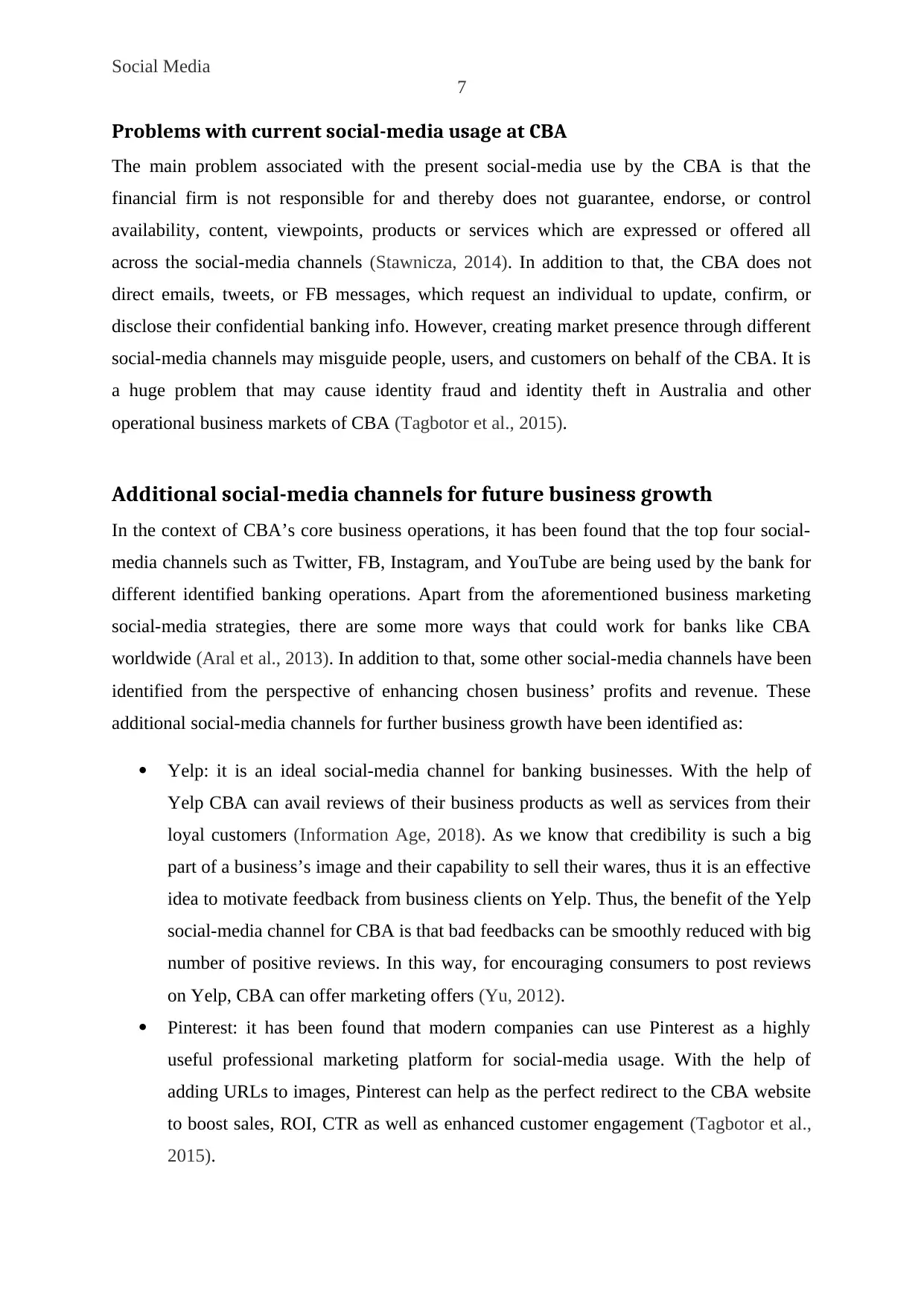
Social Media
7
Problems with current social-media usage at CBA
The main problem associated with the present social-media use by the CBA is that the
financial firm is not responsible for and thereby does not guarantee, endorse, or control
availability, content, viewpoints, products or services which are expressed or offered all
across the social-media channels (Stawnicza, 2014). In addition to that, the CBA does not
direct emails, tweets, or FB messages, which request an individual to update, confirm, or
disclose their confidential banking info. However, creating market presence through different
social-media channels may misguide people, users, and customers on behalf of the CBA. It is
a huge problem that may cause identity fraud and identity theft in Australia and other
operational business markets of CBA (Tagbotor et al., 2015).
Additional social-media channels for future business growth
In the context of CBA’s core business operations, it has been found that the top four social-
media channels such as Twitter, FB, Instagram, and YouTube are being used by the bank for
different identified banking operations. Apart from the aforementioned business marketing
social-media strategies, there are some more ways that could work for banks like CBA
worldwide (Aral et al., 2013). In addition to that, some other social-media channels have been
identified from the perspective of enhancing chosen business’ profits and revenue. These
additional social-media channels for further business growth have been identified as:
Yelp: it is an ideal social-media channel for banking businesses. With the help of
Yelp CBA can avail reviews of their business products as well as services from their
loyal customers (Information Age, 2018). As we know that credibility is such a big
part of a business’s image and their capability to sell their wares, thus it is an effective
idea to motivate feedback from business clients on Yelp. Thus, the benefit of the Yelp
social-media channel for CBA is that bad feedbacks can be smoothly reduced with big
number of positive reviews. In this way, for encouraging consumers to post reviews
on Yelp, CBA can offer marketing offers (Yu, 2012).
Pinterest: it has been found that modern companies can use Pinterest as a highly
useful professional marketing platform for social-media usage. With the help of
adding URLs to images, Pinterest can help as the perfect redirect to the CBA website
to boost sales, ROI, CTR as well as enhanced customer engagement (Tagbotor et al.,
2015).
7
Problems with current social-media usage at CBA
The main problem associated with the present social-media use by the CBA is that the
financial firm is not responsible for and thereby does not guarantee, endorse, or control
availability, content, viewpoints, products or services which are expressed or offered all
across the social-media channels (Stawnicza, 2014). In addition to that, the CBA does not
direct emails, tweets, or FB messages, which request an individual to update, confirm, or
disclose their confidential banking info. However, creating market presence through different
social-media channels may misguide people, users, and customers on behalf of the CBA. It is
a huge problem that may cause identity fraud and identity theft in Australia and other
operational business markets of CBA (Tagbotor et al., 2015).
Additional social-media channels for future business growth
In the context of CBA’s core business operations, it has been found that the top four social-
media channels such as Twitter, FB, Instagram, and YouTube are being used by the bank for
different identified banking operations. Apart from the aforementioned business marketing
social-media strategies, there are some more ways that could work for banks like CBA
worldwide (Aral et al., 2013). In addition to that, some other social-media channels have been
identified from the perspective of enhancing chosen business’ profits and revenue. These
additional social-media channels for further business growth have been identified as:
Yelp: it is an ideal social-media channel for banking businesses. With the help of
Yelp CBA can avail reviews of their business products as well as services from their
loyal customers (Information Age, 2018). As we know that credibility is such a big
part of a business’s image and their capability to sell their wares, thus it is an effective
idea to motivate feedback from business clients on Yelp. Thus, the benefit of the Yelp
social-media channel for CBA is that bad feedbacks can be smoothly reduced with big
number of positive reviews. In this way, for encouraging consumers to post reviews
on Yelp, CBA can offer marketing offers (Yu, 2012).
Pinterest: it has been found that modern companies can use Pinterest as a highly
useful professional marketing platform for social-media usage. With the help of
adding URLs to images, Pinterest can help as the perfect redirect to the CBA website
to boost sales, ROI, CTR as well as enhanced customer engagement (Tagbotor et al.,
2015).
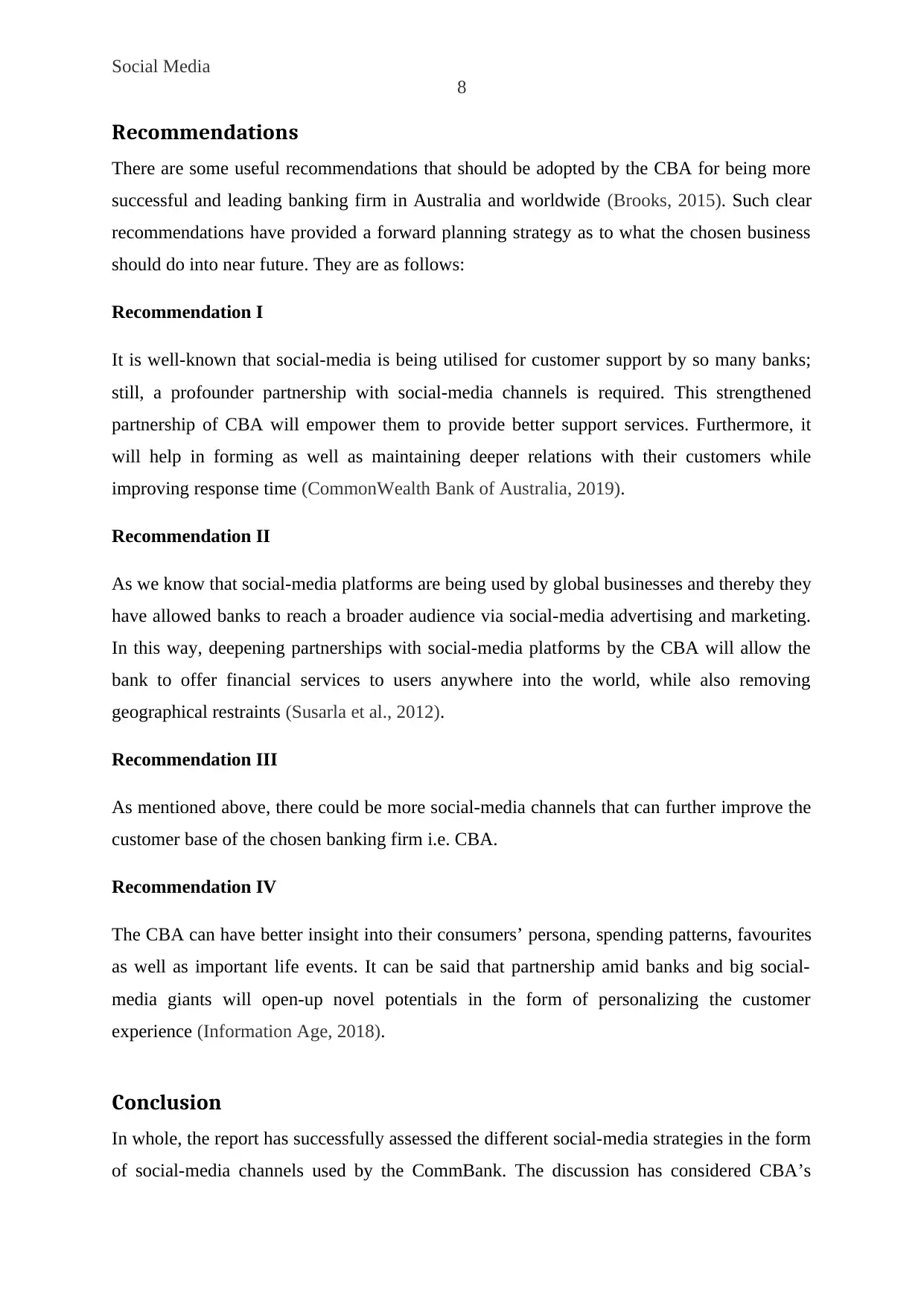
Social Media
8
Recommendations
There are some useful recommendations that should be adopted by the CBA for being more
successful and leading banking firm in Australia and worldwide (Brooks, 2015). Such clear
recommendations have provided a forward planning strategy as to what the chosen business
should do into near future. They are as follows:
Recommendation I
It is well-known that social-media is being utilised for customer support by so many banks;
still, a profounder partnership with social-media channels is required. This strengthened
partnership of CBA will empower them to provide better support services. Furthermore, it
will help in forming as well as maintaining deeper relations with their customers while
improving response time (CommonWealth Bank of Australia, 2019).
Recommendation II
As we know that social-media platforms are being used by global businesses and thereby they
have allowed banks to reach a broader audience via social-media advertising and marketing.
In this way, deepening partnerships with social-media platforms by the CBA will allow the
bank to offer financial services to users anywhere into the world, while also removing
geographical restraints (Susarla et al., 2012).
Recommendation III
As mentioned above, there could be more social-media channels that can further improve the
customer base of the chosen banking firm i.e. CBA.
Recommendation IV
The CBA can have better insight into their consumers’ persona, spending patterns, favourites
as well as important life events. It can be said that partnership amid banks and big social-
media giants will open-up novel potentials in the form of personalizing the customer
experience (Information Age, 2018).
Conclusion
In whole, the report has successfully assessed the different social-media strategies in the form
of social-media channels used by the CommBank. The discussion has considered CBA’s
8
Recommendations
There are some useful recommendations that should be adopted by the CBA for being more
successful and leading banking firm in Australia and worldwide (Brooks, 2015). Such clear
recommendations have provided a forward planning strategy as to what the chosen business
should do into near future. They are as follows:
Recommendation I
It is well-known that social-media is being utilised for customer support by so many banks;
still, a profounder partnership with social-media channels is required. This strengthened
partnership of CBA will empower them to provide better support services. Furthermore, it
will help in forming as well as maintaining deeper relations with their customers while
improving response time (CommonWealth Bank of Australia, 2019).
Recommendation II
As we know that social-media platforms are being used by global businesses and thereby they
have allowed banks to reach a broader audience via social-media advertising and marketing.
In this way, deepening partnerships with social-media platforms by the CBA will allow the
bank to offer financial services to users anywhere into the world, while also removing
geographical restraints (Susarla et al., 2012).
Recommendation III
As mentioned above, there could be more social-media channels that can further improve the
customer base of the chosen banking firm i.e. CBA.
Recommendation IV
The CBA can have better insight into their consumers’ persona, spending patterns, favourites
as well as important life events. It can be said that partnership amid banks and big social-
media giants will open-up novel potentials in the form of personalizing the customer
experience (Information Age, 2018).
Conclusion
In whole, the report has successfully assessed the different social-media strategies in the form
of social-media channels used by the CommBank. The discussion has considered CBA’s
⊘ This is a preview!⊘
Do you want full access?
Subscribe today to unlock all pages.

Trusted by 1+ million students worldwide
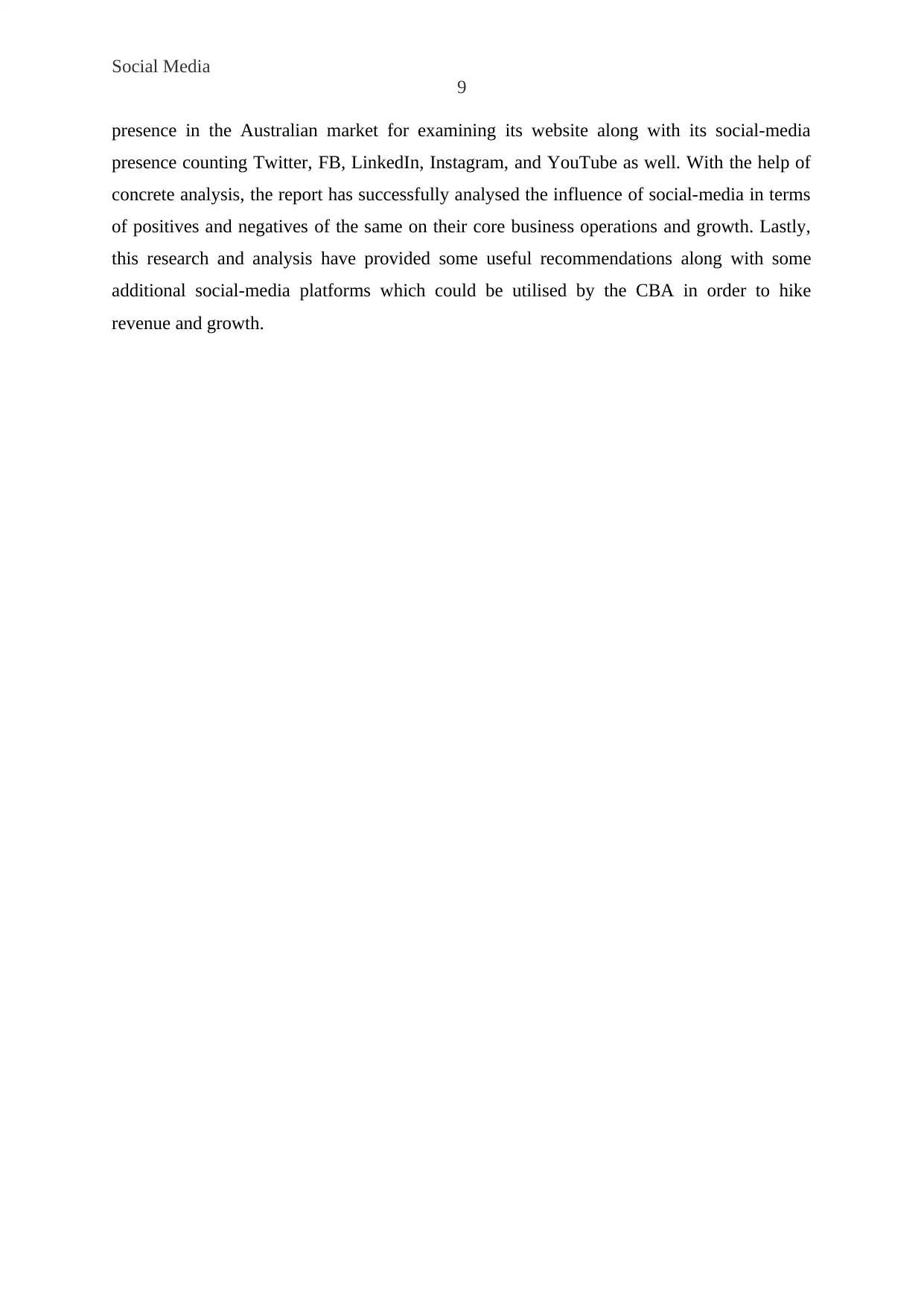
Social Media
9
presence in the Australian market for examining its website along with its social-media
presence counting Twitter, FB, LinkedIn, Instagram, and YouTube as well. With the help of
concrete analysis, the report has successfully analysed the influence of social-media in terms
of positives and negatives of the same on their core business operations and growth. Lastly,
this research and analysis have provided some useful recommendations along with some
additional social-media platforms which could be utilised by the CBA in order to hike
revenue and growth.
9
presence in the Australian market for examining its website along with its social-media
presence counting Twitter, FB, LinkedIn, Instagram, and YouTube as well. With the help of
concrete analysis, the report has successfully analysed the influence of social-media in terms
of positives and negatives of the same on their core business operations and growth. Lastly,
this research and analysis have provided some useful recommendations along with some
additional social-media platforms which could be utilised by the CBA in order to hike
revenue and growth.
Paraphrase This Document
Need a fresh take? Get an instant paraphrase of this document with our AI Paraphraser
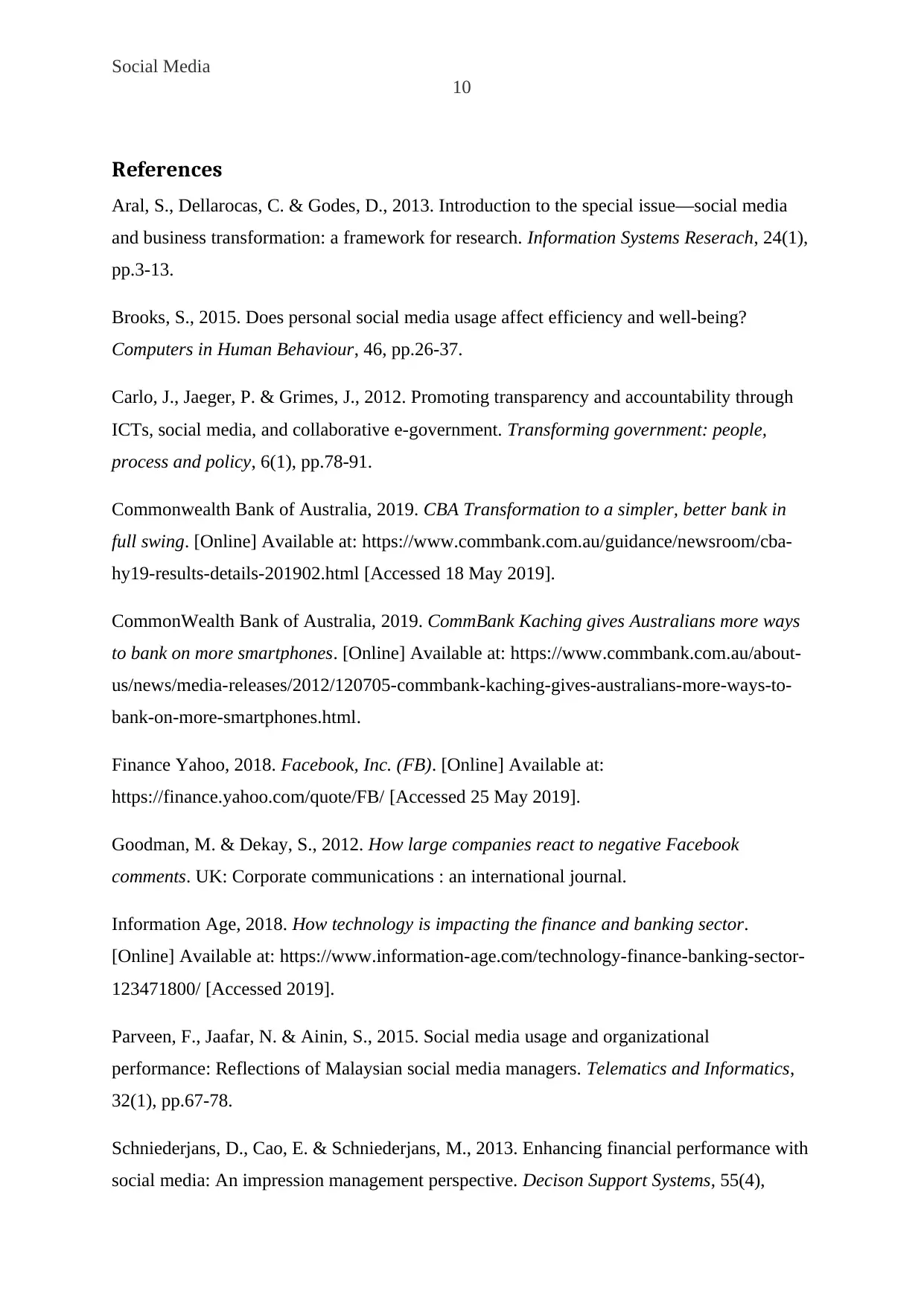
Social Media
10
References
Aral, S., Dellarocas, C. & Godes, D., 2013. Introduction to the special issue—social media
and business transformation: a framework for research. Information Systems Reserach, 24(1),
pp.3-13.
Brooks, S., 2015. Does personal social media usage affect efficiency and well-being?
Computers in Human Behaviour, 46, pp.26-37.
Carlo, J., Jaeger, P. & Grimes, J., 2012. Promoting transparency and accountability through
ICTs, social media, and collaborative e-government. Transforming government: people,
process and policy, 6(1), pp.78-91.
Commonwealth Bank of Australia, 2019. CBA Transformation to a simpler, better bank in
full swing. [Online] Available at: https://www.commbank.com.au/guidance/newsroom/cba-
hy19-results-details-201902.html [Accessed 18 May 2019].
CommonWealth Bank of Australia, 2019. CommBank Kaching gives Australians more ways
to bank on more smartphones. [Online] Available at: https://www.commbank.com.au/about-
us/news/media-releases/2012/120705-commbank-kaching-gives-australians-more-ways-to-
bank-on-more-smartphones.html.
Finance Yahoo, 2018. Facebook, Inc. (FB). [Online] Available at:
https://finance.yahoo.com/quote/FB/ [Accessed 25 May 2019].
Goodman, M. & Dekay, S., 2012. How large companies react to negative Facebook
comments. UK: Corporate communications : an international journal.
Information Age, 2018. How technology is impacting the finance and banking sector.
[Online] Available at: https://www.information-age.com/technology-finance-banking-sector-
123471800/ [Accessed 2019].
Parveen, F., Jaafar, N. & Ainin, S., 2015. Social media usage and organizational
performance: Reflections of Malaysian social media managers. Telematics and Informatics,
32(1), pp.67-78.
Schniederjans, D., Cao, E. & Schniederjans, M., 2013. Enhancing financial performance with
social media: An impression management perspective. Decison Support Systems, 55(4),
10
References
Aral, S., Dellarocas, C. & Godes, D., 2013. Introduction to the special issue—social media
and business transformation: a framework for research. Information Systems Reserach, 24(1),
pp.3-13.
Brooks, S., 2015. Does personal social media usage affect efficiency and well-being?
Computers in Human Behaviour, 46, pp.26-37.
Carlo, J., Jaeger, P. & Grimes, J., 2012. Promoting transparency and accountability through
ICTs, social media, and collaborative e-government. Transforming government: people,
process and policy, 6(1), pp.78-91.
Commonwealth Bank of Australia, 2019. CBA Transformation to a simpler, better bank in
full swing. [Online] Available at: https://www.commbank.com.au/guidance/newsroom/cba-
hy19-results-details-201902.html [Accessed 18 May 2019].
CommonWealth Bank of Australia, 2019. CommBank Kaching gives Australians more ways
to bank on more smartphones. [Online] Available at: https://www.commbank.com.au/about-
us/news/media-releases/2012/120705-commbank-kaching-gives-australians-more-ways-to-
bank-on-more-smartphones.html.
Finance Yahoo, 2018. Facebook, Inc. (FB). [Online] Available at:
https://finance.yahoo.com/quote/FB/ [Accessed 25 May 2019].
Goodman, M. & Dekay, S., 2012. How large companies react to negative Facebook
comments. UK: Corporate communications : an international journal.
Information Age, 2018. How technology is impacting the finance and banking sector.
[Online] Available at: https://www.information-age.com/technology-finance-banking-sector-
123471800/ [Accessed 2019].
Parveen, F., Jaafar, N. & Ainin, S., 2015. Social media usage and organizational
performance: Reflections of Malaysian social media managers. Telematics and Informatics,
32(1), pp.67-78.
Schniederjans, D., Cao, E. & Schniederjans, M., 2013. Enhancing financial performance with
social media: An impression management perspective. Decison Support Systems, 55(4),
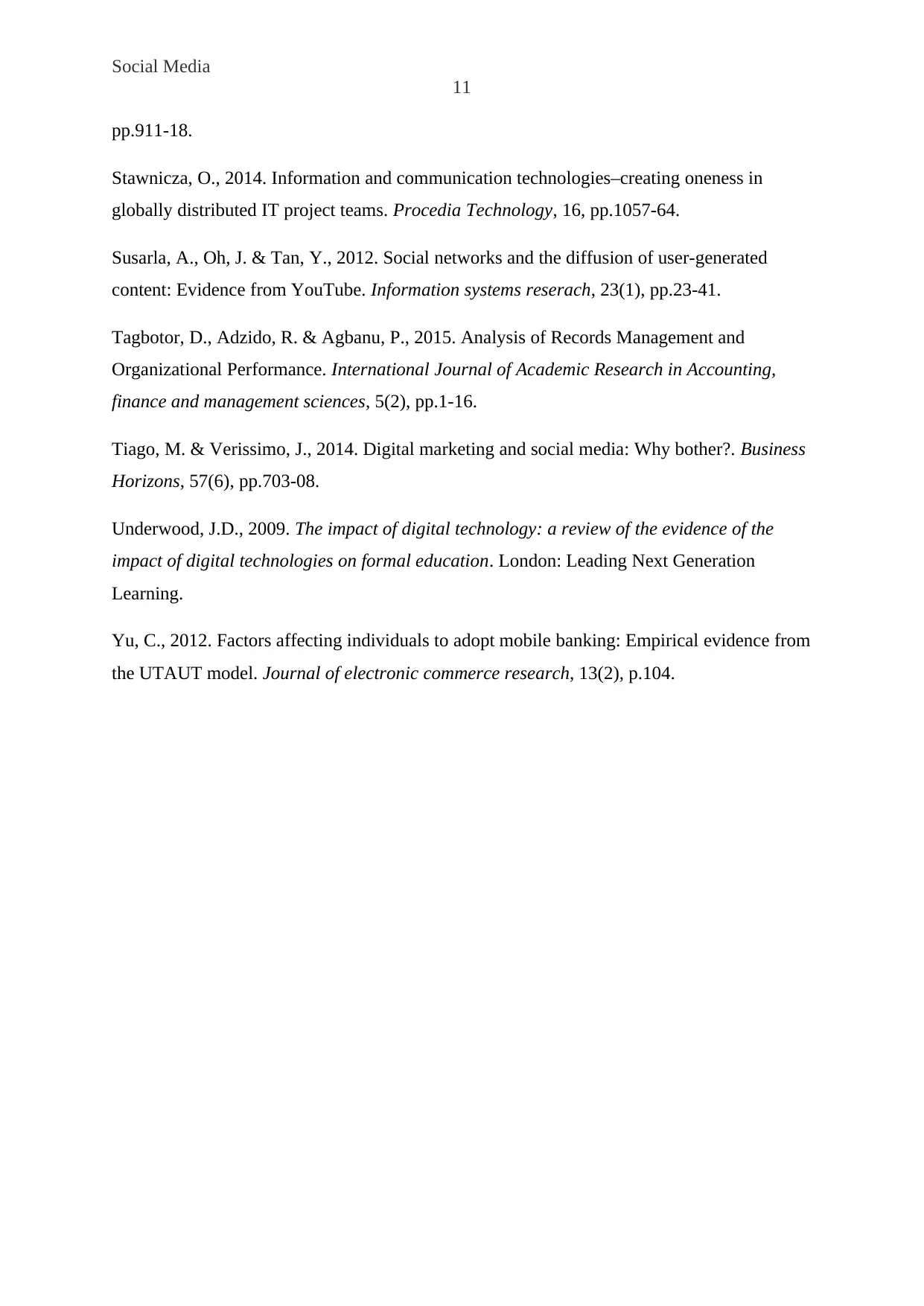
Social Media
11
pp.911-18.
Stawnicza, O., 2014. Information and communication technologies–creating oneness in
globally distributed IT project teams. Procedia Technology, 16, pp.1057-64.
Susarla, A., Oh, J. & Tan, Y., 2012. Social networks and the diffusion of user-generated
content: Evidence from YouTube. Information systems reserach, 23(1), pp.23-41.
Tagbotor, D., Adzido, R. & Agbanu, P., 2015. Analysis of Records Management and
Organizational Performance. International Journal of Academic Research in Accounting,
finance and management sciences, 5(2), pp.1-16.
Tiago, M. & Verissimo, J., 2014. Digital marketing and social media: Why bother?. Business
Horizons, 57(6), pp.703-08.
Underwood, J.D., 2009. The impact of digital technology: a review of the evidence of the
impact of digital technologies on formal education. London: Leading Next Generation
Learning.
Yu, C., 2012. Factors affecting individuals to adopt mobile banking: Empirical evidence from
the UTAUT model. Journal of electronic commerce research, 13(2), p.104.
11
pp.911-18.
Stawnicza, O., 2014. Information and communication technologies–creating oneness in
globally distributed IT project teams. Procedia Technology, 16, pp.1057-64.
Susarla, A., Oh, J. & Tan, Y., 2012. Social networks and the diffusion of user-generated
content: Evidence from YouTube. Information systems reserach, 23(1), pp.23-41.
Tagbotor, D., Adzido, R. & Agbanu, P., 2015. Analysis of Records Management and
Organizational Performance. International Journal of Academic Research in Accounting,
finance and management sciences, 5(2), pp.1-16.
Tiago, M. & Verissimo, J., 2014. Digital marketing and social media: Why bother?. Business
Horizons, 57(6), pp.703-08.
Underwood, J.D., 2009. The impact of digital technology: a review of the evidence of the
impact of digital technologies on formal education. London: Leading Next Generation
Learning.
Yu, C., 2012. Factors affecting individuals to adopt mobile banking: Empirical evidence from
the UTAUT model. Journal of electronic commerce research, 13(2), p.104.
⊘ This is a preview!⊘
Do you want full access?
Subscribe today to unlock all pages.

Trusted by 1+ million students worldwide
1 out of 12
Related Documents
Your All-in-One AI-Powered Toolkit for Academic Success.
+13062052269
info@desklib.com
Available 24*7 on WhatsApp / Email
![[object Object]](/_next/static/media/star-bottom.7253800d.svg)
Unlock your academic potential
Copyright © 2020–2025 A2Z Services. All Rights Reserved. Developed and managed by ZUCOL.





